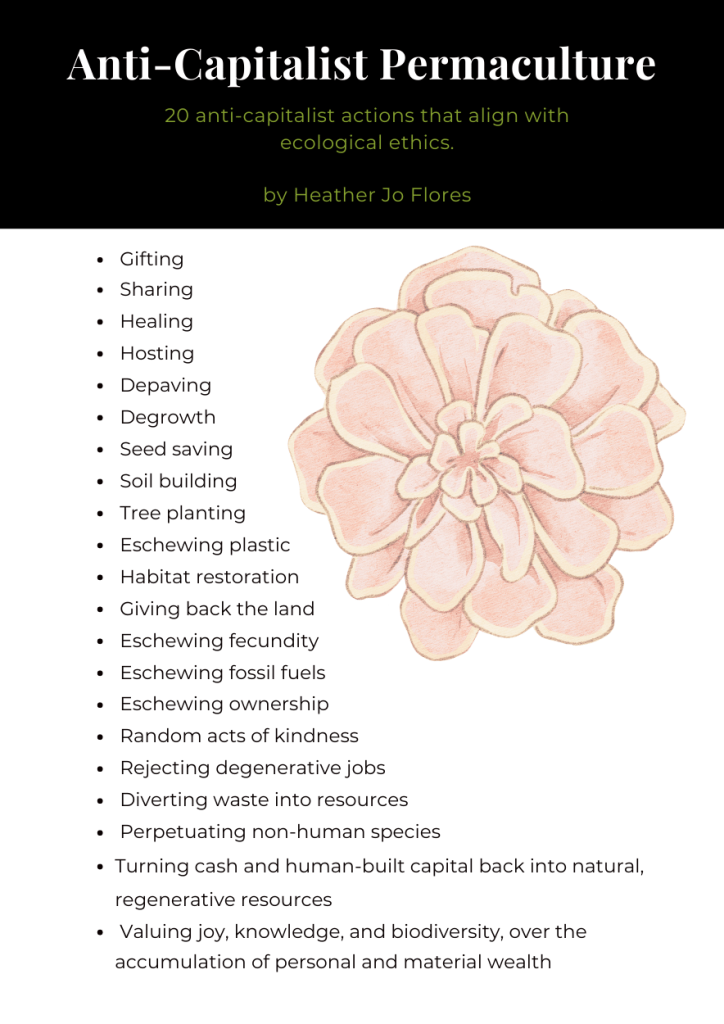
The Impact of Capitalism and Gentrification on Permaculture and Mental Well-being
We all love that vision of the small-scale food forest that produces enough extra raspberries for the kids in the neighborhood. We want to live humble, regenerative lives that care for the Earth, care for the people, and give back.
But the harsh reality is that most of the permaculture students I meet are so far from access to land that the permie fantasy is basically science fiction. And as a person who has installed countless gardens in rented spaces and then been eventuallu pushed out by the landowners time and time again, I am here to tell you: after about 2 decades of trying to overcome the economic barriers to access, it can get pretty hard to start from scratch again.
Economics are one of the invisible structures we must consider in our ecological design work, and it’s one that has an especially huge impact on our “inner landscape.” This is something we don’t talk about enough, so I’m here to toss some ideas around.
In the context of permaculture, the dual forces of capitalism and gentrification pose a significant obstacle. They don’t just alter the physical landscape; they impact our mental well-being, creating a state of instability that’s hard to balance with sustainable, mindful living.
The forces that drive gentrification—rising property values, community displacement, loss of green spaces—directly affect our ability to engage in permaculture projects on a household scale. If you’re worried about eviction or rising costs, how can you invest in a long-term permaculture design? This financial stress also takes a toll on mental health, making it even more challenging to be an effective permaculture designer who’s attuned to the subtleties of their environment.
At the same time, the broader capitalist system contributes to this instability. Capitalism encourages competition over community, profit over people, creating a cycle where the rich get richer, and communities are left to pick up the pieces. This often leads to crucial social issues like food insecurity, racial inequality, and lack of access to affordable housing—all of which deeply affect both our ability to engage with permaculture and our mental well-being.
In such a system, focusing solely on perfecting your permaculture designs or improving your mental well-being can feel like an uphill battle. Both the outer world (your immediate permaculture project) and your inner world (your mental health) are heavily influenced by these larger forces. Recognizing this is the first step toward creating designs that are not just sustainable but also resilient and adaptive, capable of weathering both economic and emotional storms.
Incorporating this understanding into your permaculture practice means not only focusing on the soil, plants, and immediate community but also advocating for systemic change. It requires creating designs that can adapt to shifting circumstances, like portable or small-scale projects that can move with you, and implementing community-supported agriculture models that build communal resources rather than individual ownership.
On the mental well-being side, it means understanding that your emotional landscape is directly tied to these broader social and economic systems. Resilience, in this case, doesn’t just mean personal emotional resilience but also community resilience—the capacity for your community to support each other emotionally and materially, thereby making individual well-being more attainable even in an unstable environment.
The goal is to expand the practice of permaculture to include these broader social considerations, recognizing that mental health and economic stability are vital elements of any truly sustainable design.
Here are some of the many ways that gentrification and capitalism make practicing permaculture more difficult. These barriers are substantial but recognizing them is the first step in designing our way through the challenges.
- Limited Access to Land: Gentrification inflates property values, which poses a hurdle for community-led permaculture projects.
- Displacement of Local Knowledge: Long-term residents, who hold essential local ecological knowledge, are forced to move.
- Loss of Emotional Resilience: The act of displacement breaks social bonds, affecting community emotional resilience.
- Resource Misallocation: City resources shift to align with gentrification, sidelining community gardens or permaculture initiatives.
- Mental Health Neglect: The neglect also extends to mental health resources.
- Cultural Erosion: Local cultures, which often have traditional sustainable living practices, get diluted.
- Loss of Emotional Stability: This change impacts a community’s sense of belonging and collective emotional health.
- Zoning Complications: New laws may restrict permaculture activities like livestock keeping or rainwater capture systems.
- Funding Diversion: Community funds are redirected to align with the new, wealthier residents’ agenda.
- Green Space Commercialization: New parks might focus on aesthetics over food production or biodiversity.
- Short-Term Profit Focus: Quick financial gains become the priority, undermining long-term sustainability.
- Barrier to Entry: Rising costs make permaculture training and educational spaces less accessible.
- Loss of Diversity: Neighborhood “marketability” drives down both plant and human diversity, weakening resilience.
- Volunteer Base Erosion: The loss of residents leads to the loss of crucial volunteers.
- Loss of Emotional Investment: Displaced volunteers often mean a loss in emotional investment in the community.
- Trauma Paralysis: The cumulative emotional and psychological impacts can lead to a state where you sort of give up, making proactive community action difficult.
While the list is extensive and the challenges are real, we must remember that the core of permaculture is creative problem-solving. We can’t afford to ignore these issues; instead, we should leverage them as critical design constraints that inform more robust, equitable, and resilient solutions. Our best path forward is to design our way through these challenges, continually adapting and striving for a sustainable, inclusive community for everyone.
How can we tackle these real and significant challenges?
Let’s brainstorm a list of permaculture-style strategies:
- Adopt Portable Designs. Develop permaculture projects with a portable design, allowing for easy relocation in response to rising property values or displacement threats.
- Community-Supported Agriculture. Implement community-supported agriculture models that prioritize communal resources over individual ownership, fostering community resilience in the face of economic instability.
- Advocate for Systemic Change. Extend permaculture practice beyond immediate concerns, advocating for systemic changes that address issues such as housing affordability, community displacement, and access to green spaces.
- Emphasize Mental Well-being. Integrate awareness of the impact of economic and social systems on mental health into permaculture practice, emphasizing the importance of individual and community emotional resilience.
- Promote Green Spaces with Purpose. Advocate for green spaces that prioritize food production and biodiversity over purely aesthetic considerations, ensuring they contribute to both physical and emotional well-being.
- Educational Initiatives for Accessibility. Develop initiatives to make permaculture training and educational spaces more accessible, addressing rising costs as a barrier to entry.
- Preserve Local Ecological Knowledge. Actively work to preserve local ecological knowledge by supporting long-term residents who hold essential information about sustainable living practices.
- Community Network Strengthening. Focus on strengthening existing social structures key to community-based permaculture projects, promoting emotional and mental health support systems.
- Diversify Funding Streams. Seek and diversify funding sources for community well-being programs, preventing resources from being diverted due to gentrification.
- Resilient Resource Allocation. Design projects with resilience in mind, considering potential resource misallocation due to gentrification and ensuring that community gardens and permaculture initiatives are not sidelined.
- Collaborative Design Platforms. Foster collaborative design platforms that engage the community in shaping permaculture projects, ensuring inclusivity and preventing neglect of existing initiatives.
- Crisis-Ready Mental Health Resources. Develop crisis-ready mental health resources tailored to the emotional impacts of gentrification-induced instability, addressing the prolonged stress and mental health issues.
Remember, the essence of permaculture is innovation. By integrating what we’ve learned, and always working with nature rather than against it, we can turn problems into solutions and manifest more resilient, equitable, and sustainable communities.
So, is permaculture anti-capitalist by definition?
Probably. Here’s a video that explains why:
Building an Emotional Toolkit
Our own creativity is of our most powerful tools for coping with overwhelming and oppressive conditions. Understanding your emotional landscape is critical for well-being and if you want to reach you full potential as an ecological designer, you’ll need a well-equipped “emotional permaculture toolkit.” A well-rounded emotional permaculture toolkit incorporates various principles, ethics, and methodologies that enhance emotional well-being, resilience, and adaptability. By bringing in elements from systems thinking, design thinking, ecological ethics, permaculture principles, feedback, and humility, you can create a robust emotional toolkit tailored to your specific needs.
Here are some ideas:
- Emotional Self-Assessment
Think of self-assessment as your foundational tool for gauging the health of your emotional landscape. Systems thinking teaches us to recognize patterns; do this daily to identify recurring emotional states and their triggers. In this way, you develop a clear picture of your emotional zones and sectors. - Healthy and Assertive Boundary Setting
Using design thinking and ecological ethics, establish boundaries that protect your emotional well-being and respect your personal limits. When setting boundaries, maintain the humility to admit when things are not working and make changes as needed. Just as ecological boundaries protect natural habitats, your emotional boundaries safeguard your mental well-being. - Mindfulness Techniques
Mindfulness is like the feedback mechanism in a well-designed system. It’s about observing without judgment, gathering data that can be used to adjust and refine your emotional landscape. You can employ simple meditation techniques to identify patterns and triggers, making sure to keep an open, humble mindset. The goal here is to better understand the emotional data points you’ve collected through self-assessment. - Support Network
A support network acts as your “companion plants,” offering resilience and balance to your emotional ecosystem. Apply the permaculture principle of “Use and value diversity” to include a range of individuals who can offer different kinds of emotional support. - Goal Setting with GOBRADIME
Your emotional objectives can be mapped out using the GOBRADIME process. Break down your larger emotional goals into achievable objectives. Identify the resources you have or need, plan actionable steps, and continually evaluate your progress. The GOBRADIME process aligns well with a design mindset, allowing you to iterate and adapt. - Resilience Practices
Incorporate habits or activities that build emotional resilience, echoing the permaculture principle of “Use edges and value the marginal.” These can be small daily rituals, hobbies, or exercise—anything that helps you bounce back and adapt to change. So…g out and get rejected! Get out of your comfort zone! - Journaling for Feedback and Adaptation
Journaling acts as a feedback loop for your emotional landscape, enabling you to track your thoughts, feelings, and reactions over time. By reviewing your journal entries, you can apply permaculture principles like “Observe and interact” and “Apply self-regulation and accept feedback” to continually adapt and refine your emotional toolkit. - Open Communication
Open and honest communication with yourself and others echoes the ecological ethic of caring for people. Create a safe space where you can express your feelings and needs, allowing for the humility to listen and make necessary adjustments. - Ethical Considerations
Just as in ecological ethics, maintain a sense of responsibility towards yourself and your emotional landscape. Act with integrity and honesty, and make choices that contribute positively to your overall emotional well-being. And above all–be kind to yourself!
By incorporating these elements into your emotional permaculture toolkit, you can approach emotional well-being with the same robust, adaptable, and ethical considerations that define permaculture. This is not a fixed toolkit but a dynamic one, capable of adapting and growing with you as you journey through the emotional landscapes of your life.

Designing Our Way Through Economic and Emotional Challenges: in Conclusion
In grappling with economic complexities, it’s crucial to ground ourselves in the core ethics of permaculture: Earth Care, People Care, and Mutual Aid. These ethics stand in direct contrast to the mainstream capitalist economy, which prioritizes financial gain while often disregarding natural and human capital. This economic model exacerbates environmental degradation, fractures human societies, and undermines the social fabric.
Land ownership is a glaring example of capitalism’s encroachment on permaculture ideals. Soaring property values form a formidable market barrier for grassroots permaculture endeavors. This inaccessibility of land is a blow to the farm-based approach that many associate with permaculture, sidelining smaller initiatives like community gardens.
Beyond physical resources, economic instability takes a psychological toll. Emotional resilience is crucial for active participation in any social movement. Financial pressures brought on by issues like gentrification sap the human capital vital for community-building initiatives. This situation is at odds with the principles of permaculture, which underscore the importance of renewable resources and services.
Despite its challenges, the permaculture movement serves as a counterpoint to the existing capitalist framework. Conventional definitions of freedom and self-sufficiency are skewed in an economically unequal society. Here, the concept of permaculture shines as a beacon, introducing the gift economy into its diverse capital forms. Unlike a strictly profit-driven market, the gift economy fosters a society based on mutual aid, ethical living, and sustainable practices.
When it comes to emotional health, it’s key to recognize its interconnection with broader societal systems. Human capital is central here; a community’s resilience is reflected in the resilience of its individuals. And this isn’t just emotional strength; it’s the collective ability to weather economic ups and downs through shared resources and support networks.
Permaculture’s potential transcends narrowly defined approaches like “Natural Capitalism,” which assigns economic value solely to natural resources. Permaculture enriches this perspective by incorporating the human factor. It celebrates the innate relationship between human societies and the land, arguing for a balanced co-existence that enriches not just the economy but also the lives of people and the health of the planet.
In closing, permaculture’s principles offer a sturdy, flexible, and ethical way to address the intertwined challenges of economic imbalance and emotional well-being. The issues may be complex and deeply rooted, but permaculture’s core philosophy is about transforming problems into solutions. Through a comprehensive understanding of diverse capital forms and by advocating for societal shifts based on ethical and sustainable practices, we can envision a future that cherishes both the land and the people who inhabit it.
…but not if we don’t face these issues head-on.
I’d love to get your feedback on these ideas! Please join us in the ecodesignhive community forums.
And if you want to learn more about “Emotional Permaculture”, aka Zone 00 aka the “Inner Landscape,” check out this free online course:
